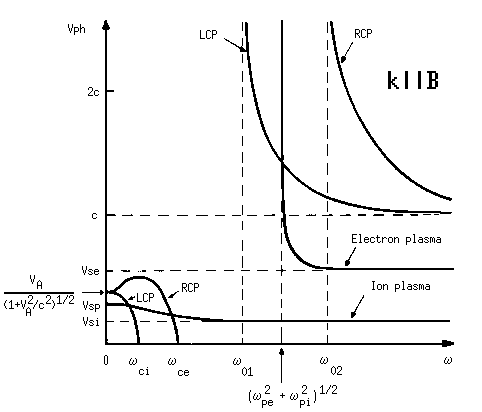 EMIC instability
EMIC instability EMIC instability
EMIC instabilityspaceweb@oulu.fi - last update: 30 November 1998, 2110 UT (RR)
Energetic magnetospheric ions are often unstable to the electromagnetic ion cyclotron (EMIC) instability. There are two important consequences of this instability:
Depending on the local proton gyrofrequency, the frequency of the EMIC waves varies: in the magnetosphere we deal with the ULF range (more precisely 0.1-5 Hz), while in the auroral field lines we have ELF waves (tens or hundreds of Hz; see radio frequencies and flickering aurora). In the former case, the free energy is provided by anisotropic energetic protons, while the precipitating electrons are thought to constitute the energy in the latter case (e.g., Oscarsson et al., 1997).
The energy for the magnetospheric EMIC waves comes from the anisotropic energetic (10-a few 100 keV, i.e., ring current and plasma sheet type) protons, for which Tperp>Tpar. Parameter A = Tperp/Tpar - 1 is called the thermal anisotropy of a particle species with a bi-Maxwellian distribution function. Energy can be transferred from the particles to the waves when the particle gyrofrequency matches the Doppler shifted wave frequency. The effective amplification of EMIC waves depends on the amount of time spent propagating through a finite growth region (Kozyra et al., 1984). Hence a convective growth rate of the instability is used instead of the temporal one; it is calculated by dividing the temporal growth rate by the group velocity of the waves. The group velocity is related to the Alfvén velocity Va, and enhanced cold plasma densities and low magnetic field strengths (= low Va) favour the wave growth. Since the magnetic field lines have minimum field strength at the equator, where also the energetic ion fluxes and anisotropies peak, the wave growth occurs there. The EMIC waves generated inside the magnetosphere are in the 0.1-5 Hz frequency range, and are called Pc 1-2 pulsations when seen on the ground (see also ULF waves).
The first mathematical treatments of EMIC generation in a proton-electron plasma were made by Cornwall (1965) and Kennel and Petschek (1966). These plasma waves are transverse, left-hand circularly polarized (LCP) waves with frequencies below the equatorial proton gyrofrequency, F(H+), at which point a resonance occurs (zero wave phase velocity, but infinite group velocity). This can be seen in the figure below, in which the warm plasma model has been used to plot the possible wave modes propagating along the field lines. The waves can travel from the equatorial source region to the ionosphere along the magnetic field lines.
| Waves travelling along the magnetic field in a warm fully ionized plasma (after Bittencourt, 1986). EMIC waves are the transverse left-hand circularly polarized (LCP) waves below the ion cyclotron frequency, w(ci). Note the non-zero low-frequency limit for the LCP and RCP phase velocities, which is due to the "warmness" of the plasma model: these are the Alfvén waves related to the Alfvén velocity, Va. |  |
Observations have shown that the simple, one ion theory for EMIC waves is not enough, as both cold and hot heavy ions are present in the magnetosphere, He+ and O+ being the most important. The heavy ions in the cold plasma can have profound effects on the generation and propagation of EMIC waves (Young et al., 1981; Gomberoff and Neira, 1983). The most notable new feature is the formation of stop bands above the heavy ion gyrofrequencies. Including He+ ions, the wave spectra is divided in two parts, with no power between F(He+) and the so-called cut-off frequency, F(cf). The waves above F(He+) seldom reach the ground because of the stop band. Another important effect is the decrease in the group velocity of the waves close to the wave source.
Following the treatment presented by Gomberoff and Neira (1983) for cold heavy ions, Kozyra et al. (1984) added the hot heavy ion populations (He+ and O+) in the equations. In many respects, hot heavy ions modify the wave growth in the same way as the cold population, especially when the ion densities of the two populations are comparable, as in the plasmaspheric bulge region or just outside the plasmasphere.
See also: